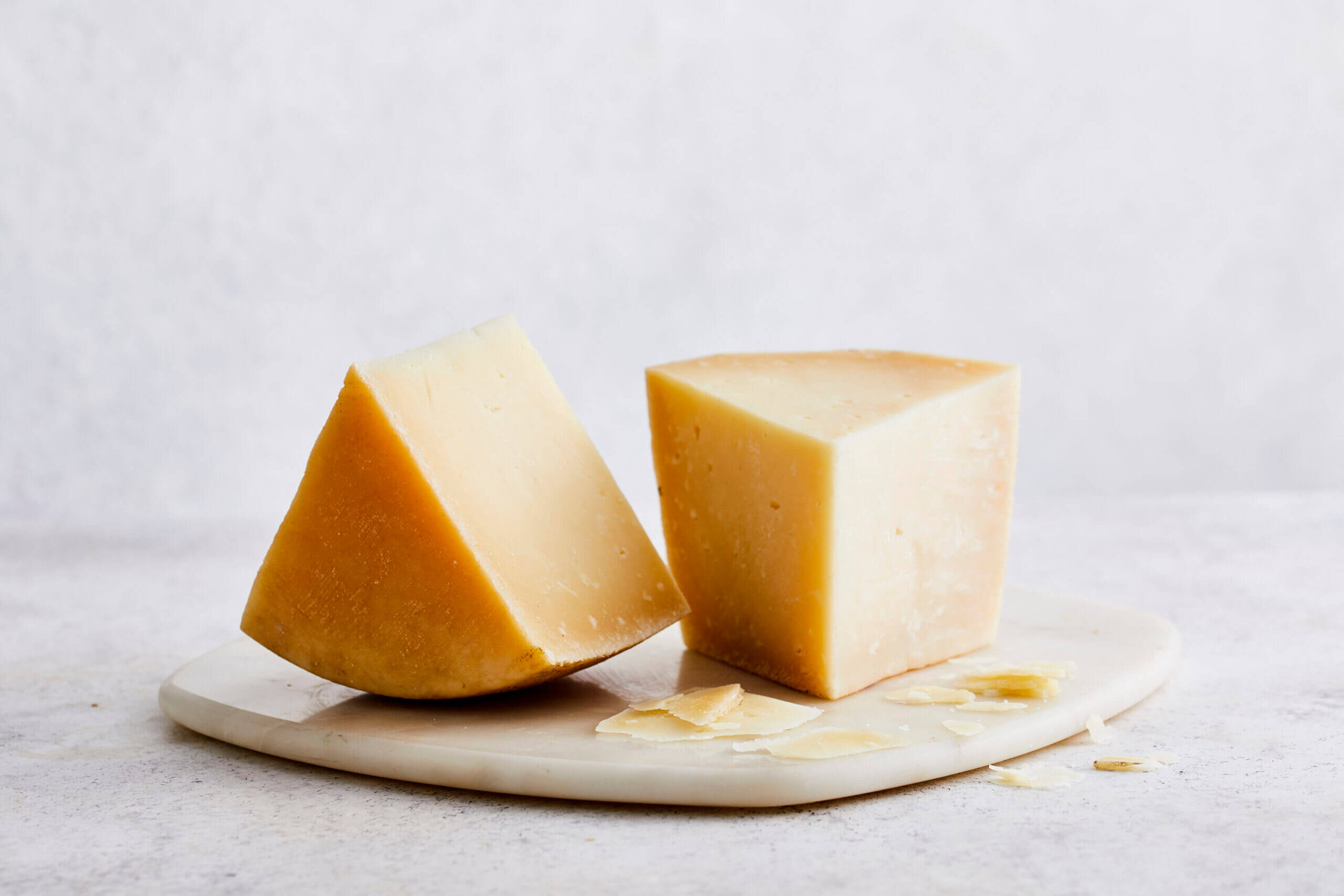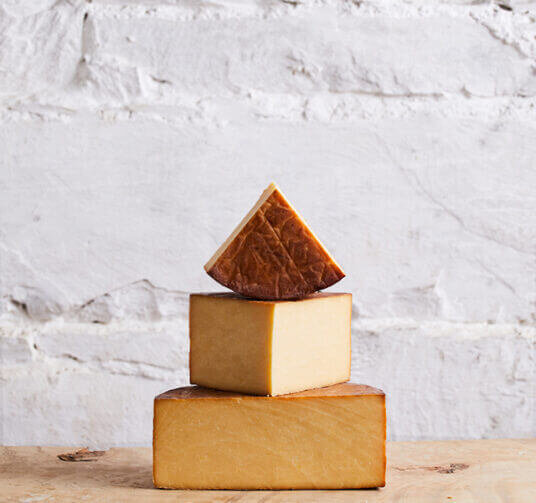8 Great Irish Cheeses You Should Know
If you think there’s not much more to Irish cheese than the Cheddars and blues that mirror their more famous cousins in neighboring England, then a drive across the Irish countryside should disabuse you of that notion. In a lush land where grazing animals easily outnumber people, it would follow that cheesemaking is as important to Irish culture as Guinness-making.
Many Irish cheeses do fall under the catch-all “farmstead cheese made in a Cheddar style” format, however there are an equal number of offerings from Ireland’s artisan cheesemakers that run the gamut of the cheese spectrum. While not all of these are available outside of Ireland at present, here are 8 Irish cheeses to know for when a trip to the Emerald Isle is in your cards.
Cashel Blue courtesy of Sheridans
Cashel Blue
According to Sheridan’s, Ireland’s largest cheese retailer, Cashel Blue is the country’s most popular cheese. (So much for my preconceived cheddar notions.) Ireland’s original blue cheese, it was first made in the 1980s on Beechmount Farm in County Tipperary by Jane and Louis Grubb to highlight the exceptional quality of the region’s grass-fed cow’s milk. (As the song goes, it may be a long way to Tipperary, but the journey is apparently well worth it given the number of Irish dairies churning out exemplary cheeses from that region.)
Cashel Blue is a semi-firm blue with a sweet and creamy paste and only the gentlest, piquant sting: a perfect blue to convert any non-believers, and regularly available in the United States, care of its distribution via London’s Neal’s Yard. The Cashel operation now also produces several other cheeses, including Crozier Blue, a sheep’s milk cheese with a richer and sharper profile than Cashel Blue.
Cáis na Tíre
Cheesemakers and young couple Barry Cahalan and Lorraine Davis took their individual farm upbringings—and agriculture degrees—and applied them to cultivating their own, small-production sheep dairy. Their first production of Cáis na Tíre—”country cheese”— in 2014 awarded them Bronze medals for both New Cheese and Sheep’s Cheese at the Irish Cheese Awards.
Made with help from neighboring Killeen Farm’s gouda expert Marion Roeleveld, Cáis na Tíre is a firm, salty cheese made from their own sheep’s milk, and produced with a modified tomme recipe. The resulting cheese is reminiscent of other firm, European, sheep’s milk cheeses such as manchego or pecorino. Ageing at least 6 months, Cáis na Tíre develops toasty caramel flavors as it goes.
Cnoc dubh courtesy of Mikes Fancy Cheese
Cnoc Dubh
Aptly named “black hill,” this stunning goat cheese is made by Larry and Anne Maguire at their sustainable venture Galway Goat Farm. Started in 2012 with a modest herd of 20 goats, the project was the brainchild of the couple who saw a gap in the Irish dairy market for high quality goat milk products.
Resembling France’s famed pyramid-shaped Valençay, this fresh goat cheese is made in a lactic style with a boost from vegetable rennet, and coated with vegetable ash to help the cheese ripen and to give it its dramatic exterior. Light and bright after 2-3 weeks of age, the cheese develops creamline potential and peppery notes after 3-6 weeks.
Coolea courtesy of Sheridans
Coolea
Made on a mountain farm in County Cork since 1980, Coolea was developed by Dutch-born Helen Willems, with milk from her husband Dick Willems’ cow herd. (The first of two cheeses on this list to represent a Dutch-Irish fusion.)
Young Coolea is classically gouda in style, with medium firmness, a buttery color, and mild, sweet notes. The Willems family offers several stages of maturity with Coolea as it continues to age, developing butterscotch flavors and crystalline textures: the most popular Coolea Matured, and the exemplary Coolea Extra Matured.
Gubbeen courtesy of Gubbeen
Gubbeen
Situated on the coast in West Cork, The Gubbeen farm is a multi-faceted operation maintained by the Ferguson family, providing all manner of artisan farmstead products from cheese to smoked meats to heirloom poultry. Cheesemaker Giana Ferguson makes only one cheese, but Gubbeen is easily the mother of Irish washed-rind cheeses.
Made from cow’s milk and cured with brine during its 1-2 months of aging, Tenaya Darlington (“Di Bruno Bros. House of Cheese”,) describes the resulting Gubbeen as the “sticky toffee pudding” of cheeses. With its blushing exterior and supple paste, it certainly has visual dessert appeal, besides which hazelnuts and butter can definitely be detected among the complex notes of its flavor profile.
Killeen courtesy of Killeen Farmhouse Cheese
Killeen Goat
Killeen is what happens when a trained, Netherlands-born cheesemaker meets exemplary Irish milk. Cheesemaker Marion Roeleveld started Killeen Farmhouse in County Galway in 2005, where she makes award-winning goat’s milk cheeses from her own herd, and cow’s milk cheese from milk bought at neighboring farms.
Roeleveld primarily makes cheese in a semi-hard gouda style using pasteurized milk. The washed-curd goat gouda is nutty and floral. Curd-washing removes acidity, leaving just the slightest lactic tang in the sweet, dense paste. Her goat’s milk gouda is also available studded with fenugreek, and cow’s milk varieties include cumin seed, basil and garlic, and Italian herbs and olives.
Knockanore smoked courtesy of Sheridans
Knockanore Smoked
Located in the township of Ballyneety in County Waterford, “Knockanore” translated is “hill of gold,” a fitting name for a farm that produces one of many of the aforementioned Irish farmhouse cheddars. From their herd of 200 Friesian cattle, Eamonn and Patricia Lonergan produce a variety of raw milk cheddars that showcases the full spectrum of cheddar colors. Additional flavor options include standouts such as onion and caraway, and horseradish and rosemary.
That it is made with raw milk already sets Knockanore apart as a cheddar with added complexity, but Knockamore Smoked is iconic in the region for its unique smoked characteristic. (Smoked gouda who?) The firm, but open-textured cheese is cold-smoked for 10 days using locally-sourced Lismore oak, resulting in a mahogany exterior and a robust, nearly meaty flavor.
wicklow blue courtesy of sheridans
Wicklow Blue
John Hempenstall started making cheese in 2005 to supplement the income from the dairy farm which his family had been operating for several generations. Now, cheesemaking is the primary business, and the creamery produces several cheeses in brie and cheddar varieties.
Wicklow Blue is my own personal pot of gold at the end of the rainbow: a blue-veined brie. The double crème brie achieves a buttery texture with a velvety bloomy rind, and the touch of veining gives it just a hint of blue attitude.
Further evidence from the Wicklow website that they have taken my pulse specifically: “Suggestions for servings include breakfast cheese, deep fried or melted served with chutney, and is delicious paired with a full-bodied wine and perfect for a cheeseboard.” Breakfast cheese? I’m moving to Ireland.








